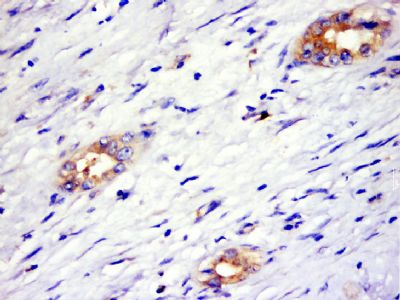SPESP1 Polyclonal Antibody
Purified Rabbit Polyclonal Antibody (Pab)
- 产品详情
- 实验流程
Application
| IHC-P, IHC-F, IF, ICC, E |
|---|---|
| Primary Accession | Q6UW49 |
| Reactivity | Rat |
| Host | Rabbit |
| Clonality | Polyclonal |
| Calculated MW | 38931 Da |
| Physical State | Liquid |
| Immunogen | KLH conjugated synthetic peptide derived from human SPESP1 |
| Epitope Specificity | 151-250/350 |
| Isotype | IgG |
| Purity | affinity purified by Protein A |
| Buffer | 0.01M TBS (pH7.4) with 1% BSA, 0.02% Proclin300 and 50% Glycerol. |
| SUBCELLULAR LOCATION | Cytoplasmic vesicle > secretory vesicle > acrosome. Small proacrosomal granules (during the Golgi phase), enlarged acrosomal vesicles (during the cap phase), acrosome (during the elongating phase), equatorial segment of the acrosome. |
| SIMILARITY | Belongs to the SPESP1 family. |
| Important Note | This product as supplied is intended for research use only, not for use in human, therapeutic or diagnostic applications. |
| Background Descriptions | SPESP1 is a 399 amino acid protein belonging to the SPESP1 family. Localizing to cytoplasmic vesicle, secretory vesicle, and acrosome, SPESP1 is highly expressed in testis, with lower levels found in placenta and fetal lung. SPESP1 establishes an equatorial segment subcompartment early in sperm development and is required for proper sperm-egg fusion. Disruption of SPESP1 leads to abnormal distribution of sperm proteins resulting in a detached membrane from the equatorial segment and less fertile sperm. SPESP1 may interact with IZUMO1 and MN9 antigen and contains an N-glycosylation site as well as several cAMP-dependent kinase, protein kinase C, and casein kinase II consensus phosphorylation sites. |
| Gene ID | 246777 |
|---|---|
| Other Names | Sperm equatorial segment protein 1 {ECO:0000312|HGNC:HGNC:15570}, SP-ESP, Equatorial segment protein, ESP, Glycosylated 38 kDa sperm protein C-7/8, SPESP1 (HGNC:15570) |
| Target/Specificity | Highly expressed in testis, where it is localized in the acrosome of postmeiotic stages of spermiogenesis (round and elongating spermatids and in ejaculated spermatozoa) (at protein level). Poorly expressed in placenta and fetal lung. |
| Dilution | IHC-P=1:100-500,IHC-F=1:100-500,ICC=1:100-500,IF=1:100-500,ELISA=1:5000-10000 |
| Format | 0.01M TBS(pH7.4) with 1% BSA, 0.09% (W/V) sodium azide and 50% Glyce |
| Storage | Store at -20 °C for one year. Avoid repeated freeze/thaw cycles. When reconstituted in sterile pH 7.4 0.01M PBS or diluent of antibody the antibody is stable for at least two weeks at 2-4 °C. |
| Name | SPESP1 (HGNC:15570) |
|---|---|
| Function | Involved in fertilization ability of sperm. |
| Cellular Location | Cytoplasmic vesicle, secretory vesicle, acrosome. Note=Small proacrosomal granules (during the Golgi phase), enlarged acrosomal vesicles (during the cap phase), acrosome (during the elongating phase), equatorial segment of the acrosome (during the maturation phase) (PubMed:12773409). After acrosome reaction localizes to the equatorial segment region in both noncapacitated and capacitated, acrosome-reacted sperm (By similarity) {ECO:0000250|UniProtKB:Q9D5A0, ECO:0000269|PubMed:12773409} |
| Tissue Location | Highly expressed in testis, where it is localized in the acrosome of postmeiotic stages of spermiogenesis (round and elongating spermatids and in ejaculated spermatozoa) (at protein level). Poorly expressed in placenta and fetal lung |
Research Areas
For Research Use Only. Not For Use In Diagnostic Procedures.
Application Protocols
Provided below are standard protocols that you may find useful for product applications.
终于等到您。ABCEPTA(百远生物)抗体产品。
点击下方“我要评价 ”按钮提交您的反馈信息,您的反馈和评价是我们最宝贵的财富之一,
我们将在1-3个工作日内处理您的反馈信息。
如有疑问,联系:0512-88856768 tech-china@abcepta.com.























 癌症的基本特征包括细胞增殖、血管生成、迁移、凋亡逃避机制和细胞永生等。找到癌症发生过程中这些通路的关键标记物和对应的抗体用于检测至关重要。
癌症的基本特征包括细胞增殖、血管生成、迁移、凋亡逃避机制和细胞永生等。找到癌症发生过程中这些通路的关键标记物和对应的抗体用于检测至关重要。 为您推荐一个泛素化位点预测神器——泛素化分析工具,可以为您的蛋白的泛素化位点作出预测和评分。
为您推荐一个泛素化位点预测神器——泛素化分析工具,可以为您的蛋白的泛素化位点作出预测和评分。 细胞自噬受体图形绘图工具为你的蛋白的细胞受体结合位点作出预测和评分,识别结合到自噬通路中的蛋白是非常重要的,便于让我们理解自噬在正常生理、病理过程中的作用,如发育、细胞分化、神经退化性疾病、压力条件下、感染和癌症。
细胞自噬受体图形绘图工具为你的蛋白的细胞受体结合位点作出预测和评分,识别结合到自噬通路中的蛋白是非常重要的,便于让我们理解自噬在正常生理、病理过程中的作用,如发育、细胞分化、神经退化性疾病、压力条件下、感染和癌症。






